| |
Click on the maps for larger image |
| |
|
| Regional Surface Meteorological Networks |
| |
|
| Union Pacific Railroad Weather Station Network - The Union Pacific Railroad
operates this network of 264 weather stations (4 in Louisiana) located in the central and western United
States. Further information on Union Pacific is available on their
home page. This network is included as part of the University of Utah
MesoWest and NOAA/Earth
System Research Laboratory (ESRL) Global Systems Division (GSD)
MADIS data sets. |
 . . |
| WWL WeatherNet
- WWL-TV in New Orleans, Louisiana operates this network of 66 stations located
primarily at schools throughout southern Louisiana (61 in Louisiana). The
network provides up to 1-minute observations of air temperature, relative
humidity, wind speed, wind direction, precipitation, and barometric pressure.
For further information visit the
WWL
network page. |
 |
| |
|
| WBRZ WeatherNet
- WBRZ-TV in Baton Rouge, Louisiana operates this network of 45 stations located
primarily at schools throughout southern Louisiana (44 in Louisiana). The
network provides up to 1-minute observations of air temperature, relative
humidity, wind speed, wind direction, precipitation, and barometric pressure.
For further information visit the
WBRZ
network page. |
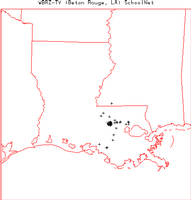 |
| |
|
| KTVE WeatherNet
- KTVE-TV in Monroe, Louisiana operates this network of 10 stations located
primarily at schools throughout northeastern Louisiana (8 in Louisiana). The
network provides up to 1-minute observations of air temperature, relative
humidity, wind speed, wind direction, precipitation, and barometric pressure.
For further information visit the
KTVE
network page. |
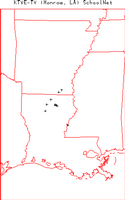 |
| |
|
| KFDM WeatherNet
- KFDM-TV in Beaumont, Texas operates this network of 42 stations located
primarily at schools throughout southeastern Texas (1 in Louisiana). The
network provides up to 1-minute observations of air temperature, relative
humidity, wind speed, wind direction, precipitation, and barometric pressure.
For further information visit the
KFDM
network page. |
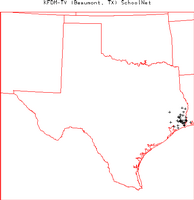 |
| |
|
| State and Local Surface Meteorological Networks |
| |
|
| Louisiana Agriclimatic Information
System (LAIS) - The Louisiana State University AgCenter operates this
network of 20 stations with locations throughout the state. The network provides
5-minute observations of air temperature, precipitation, wind speed, wind
direction, relative humidity, solar radiation, and soil temperature. For further
information visit the
LAIS home page.
This network is included in the NOAA/FSL MADIS
data set. |
 |
| |
|
| Louisiana Air Monitoring Network -
The Louisiana Department of Environmental Quality Air Monitoring Operations group
operates this network of 10 stations with locations throughout the state. The
parameters and temporal resolution are unknown. For further information visit the
Air Monitoring Operations page. |
 |
| |
|
| KATC WeatherNet
- KATC-TV in Lafayette, Louisiana operates this network of 18 stations located
primarily at schools throughout southcentral Louisiana. The
network provides up to 1-minute observations of air temperature, relative
humidity, wind speed, wind direction, precipitation, and barometric pressure.
For further information visit the
KATC
network page. |
 |
| |
|
| Precipitation and Radar Networks |
| |
|
| NOAA/National Centers for Environmental
Prediction (NCEP) Hourly Precipitation Data - NOAA/NCEP routinely develops
a National Multi-sensor Hourly Precipitation Analysis (Stage II) data set from
hourly radar precipitation estimates and from hourly gage reports. The gage data
includes hourly observations from ~4000 gages across the US (127 in Louisiana)
collected by the NOAA River Forecast Centers and sent to NCEP. Further information
on these data is available at:
http://wwwt.emc.ncep.noaa.gov/mmb/ylin/pcpanl/. |
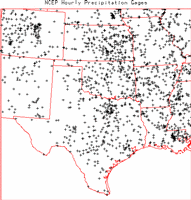 |
| |
|
| NOAA/NWS Cooperative Observer 15-minute Precipitation Network - The
NOAA/NWS
routinely collects 15-minute observations of precipitation from Fisher-Porter and Universal
rain gages operated by 2777 cooperative observers located throughout the US (48 in Louisiana).
These data are archived at NOAA/National Climatic Data Center (NCDC) as data set TD 3260.
For further information visit the NOAA/NCDC TD3260 page at:
http://ols.nndc.noaa.gov/plolstore/plsql/olstore.prodspecific?prodnum=C00505-TAP-A0001 |
 |
| |
|
| Weather Surveillance Radar 1988 Doppler (WSR-88D)
Network - The NOAA/NWS and the Department of Defense operate this network
of 143 WSR-88D radars across the contiguous US (4 in Louisiana). The Level II
data are the three meteorological base data quantities (reflectivity, mean radial
velocity, and spectrum width) and are recorded at all NWS and most DOD sites.
Level II data are then processed in order to create a number of meteorological analysis
products known as Level III data. Level III data are recorded at the NWS sites. The
Level III products included base reflectivity, base spectrum width, base velocity,
composite reflectivity, echo tops, velocity azimuth display (VAD) wind profile,
vertically integrated liquid (VIL), 1-hour precipitation, storm total precipitation,
hail index overlay, mesocyclone overlay, severe weather probability overlay, storm
structure, storm tracking information overlay, and tornadic vortex signature overlay.
All Level II and III data are archived at NOAA/NCDC. For further information visit
the NOAA/NCDC Radar Resources page at:
http://www.ncdc.noaa.gov/oa/radar/radarresources.html or the NOAA Radar
Operations Center at:
http://www.roc.noaa.gov/. |
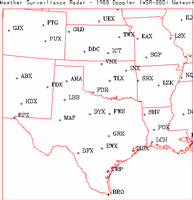 |
| |
|
| Radiation and Flux Networks |
| |
|
| Cooperative Network for Renewable Resource
Measurements (CONFRRM) Network - The National Renewable Energy Laboratory
(NREL) oversees this network of 11 radiation stations (1 in Louisiana) with
locations primarily in the southern and eastern US. The network provides 5-minute
observations of global horizontal irradiance, direct normal irradiance, and diffuse
horizontal irradiance. Some of the sites also provide various surface meteorological
parameters. For further information visit the CONFRRM home page at:
http://rredc.nrel.gov/solar/new_data/confrrm/. |
 |
| |
|
| United States Department of Agriculture (USDA)
UV-B Monitoring Network - The USDA operates this network of 29 stations
with locations throughout the US (1 in Louisiana). The network provides
3-minute observations of spectral total/direct/diffuse radiation, air temperature,
relative humidity, solar radiation, barometric pressure, and photosynthetically
active radiation. For further information visit the
USDA UV-B Monitoring page. |
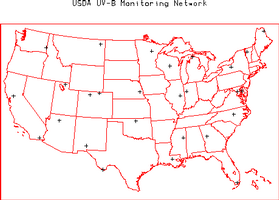 |
| |
|
| Soil Networks |
| |
|
| None at present. |
|
| |
|
| Hydrology Networks |
| |
|
| United States Geological Survey (USGS) Streamflow
Network - The USGS (part of the US Department of the Interior) operates this
network of 7237 streamflow gages (197 in Louisiana) at locations throughout the US.
The network provides hourly or more frequent observations of stage (water level) from
which discharge (flow) is computed using a stage-discharge rating relation. The
rating is defined by occasional direct current-meter measurements of discharge. All
data are available through the USGS and the district offices in each state. Many of
these gages provide realtime data
relayed via the GOES satellite data collection system. The realtime data are
provisional data that have not been reviewed or edited. These realtime data
may be subject to significant change and are not citeable until reviewed and approved
by the USGS. Realtime data may be changed after review because the stage-discharge
relationship may have been affected by: 1) backwater from ice or debris; 2) algal and
aquatic growth in the stream; 3) sediment movement; and 4) malfunction of recording
equipment. Each station record is considered provisional until the data are
published. The data are usually published with 6 months of the end of the water year
(1 October to 30 September). Data users are cautioned to consider carefully the
provisional nature of the information before using it. For further information on the
USGS streamflow network visit the
USGS Water Resources of the United
States page or the
USGS Louisiana District Office
home page. |
 |
| |
|
| Upper Air Networks |
| |
|
| NOAA/NWS Radiosonde Network Low Vertical Resolution Data - The NOAA/NWS
typically releases radiosondes twice per day at 0000 and 1200 UTC at 69 locations throughout
the US (3 in Louisiana). During special weather situations the NWS can request to release
additional radiosondes at off-times (e.g. 1800 UTC). The low resolution data is sent out
over the Global Telecommunications System (GTS) and provides mandatory and significant level
observations of pressure, altitude, temperature, dew point, wind speed, and wind direction.
There are 3 types of radiosondes utilized within the US network, Vaisala, VIZ (or Sippican),
and Microsonde. These data are archived by NOAA/NCDC and other organizations. For further
information on the NWS Radiosonde network visit the
NWS Upper-air Observations Program
home page. A several year archive of GTS upper air data is available at the
NOAA/FSL Radiosonde Database. |
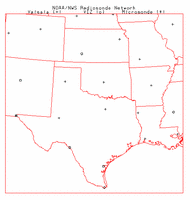 |
| |
|
| NOAA/NWS Radiosonde Network High Vertical Resolution Data - The same
radiosonde locations mentioned in the previous data set also provide a 6-second vertical
resolution data set that provides observations of pressure, temperature, altitude,
relative humidity, and azimuth and elevation angles. UCAR/JOSS has developed software
to derive 6-second vertical resolution winds from the angle data. These data are
archived by NCDC and UCAR/JOSS. |
 |
| |
|
| NOAA Profiler Network (NPN) - The NOAA/Forecast Systems Laboratory
(FSL) operates this network of 32 404 MHz wind profilers primarily across the central
portion of the United States (1 in Louisiana). Each site provides 6-minute and hourly
vertical profiles of wind speed and wind direction. Additionally, 11 of the NPN
sites have a collocated Radio Acoustic Sounding System (RASS) that provides 6-minute
and hourly vertical profiles of virtual temperature (none in Louisiana). For further
information visit the
NPN home page.
An archive of the hourly wind profiles is available from
NCAR/SCD. |
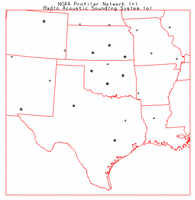 |
| |
|
| Ground Based Global Positioning System (GPS) Meteorology Demonstration Network
(GPS-MET) - The NOAA/FSL ingests data from 323 GPS locations around the US
operated by many different agencies (10 in Louisiana). Typically each location provides
30-minute observations of integrated precipitatable water along with a number of surface
meteorology parameters (air temperature, relative humidity, barometric pressure, etc).
For further information visit the
GPS-MET home page. |
 |
| |
|
| Aerosol Networks |
| |
|
| None known at this time.
| |
| |
|
| Coastal Networks |
| |
|
| Coastal-Marine Automated Network (C-MAN) -
The National Data Buoy Center (NDBC) operates this network of 55 C-MAN stations
with locations along coastlines throughout the US (1 in Louisiana). The network
typically provides hourly observations of air temperature, barometric pressure,
wind speed, wind direction, and wind gust. Some stations also provide
observations of sea water temperature, water level, waves, relative humidity,
precipitation, and visibility. For further information visit the
NDBC home page. |
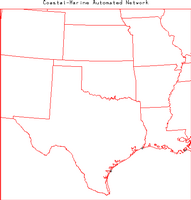 |
| |
|
| National Data Buoy Center (NDBC) Moored Buoy
Network - The NDBC operates this network of 77 moored buoys with locations
throughout the US coastal regions (1 off the coast of Louisiana). The network typically
provides hourly observations of air temperature, dew point, water temperature,
barometric pressure, wind speed, wind direction, wave height, wave period, and
swell. For further information visit the
NDBC home page. |
 |
| |
|
| National Water Level Observation Network (NWLON) - The National
Ocean Service (NOS) Center for Operational Oceanographic Products and Services (CO-OPS)
maintains a long-term database containing water-level
measurements and derived tidal data. NWLON provides water level observations at 318
locations throughout the United States. Some stations provide additional measurements
including air and water temperature, pressure and winds. For additional information
visit the NWLON web page. |
 |
| |
|
| Louisiana Universities Marine Consortium
(LUMCON) Network - LUMCON operates this network of 3 stations located
along the Louisiana coastline. The network provides at least hourly observations
of air temperature, relative humidity, barometric pressure, precipitation,
solar radition, wind speed, wind direction, water temperature, water height, and
salinity. For further information visit the
LUMCON network page. |
 |
| |
|
| Wave Current Surge Information System
for Coastal Louisiana (WAVCIS) - The Louisiana State University Coastal
Studies Institute operates this network of 6 stations located off the Louisiana
coast. The network provides at least 3-hourly observations of air temperature,
relative humidity, barometric pressure, visibility, wind speed, wind direction,
wind gust, sea surface temperature, and current and wave information. For further
information visit the
WAVCIS home page. |
 |
 .
.





















 .
.




















